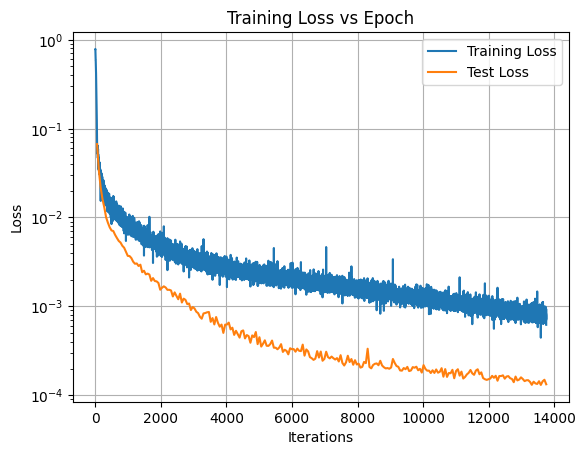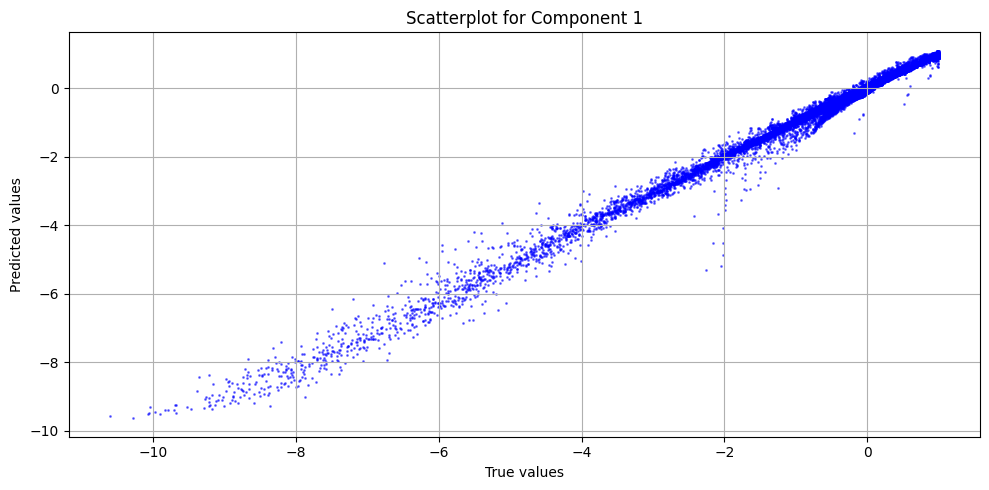How to train an MLP using the Pipeline#
Import classes and define paths#
[ ]:
from pyLOM import NN
from pathlib import Path
import torch
import warnings
warnings.filterwarnings("ignore")
[2]:
DATA_DIR = Path.cwd().parent.parent.parent.parent / "Testsuite/DATA"
CASE_DIR = Path.cwd() / "results"
NN.create_results_folder(CASE_DIR / 'models')
NN.create_results_folder(CASE_DIR / 'hyperparameters')
NN.create_results_folder(CASE_DIR / 'plots')
Folder already exists: /home/david/Desktop/pyLowOrder/docs/source/notebook_examples/NN/results/models
Folder already exists: /home/david/Desktop/pyLowOrder/docs/source/notebook_examples/NN/results/hyperparameters
Folder already exists: /home/david/Desktop/pyLowOrder/docs/source/notebook_examples/NN/results/plots
Define scalers if needed#
Here, we create 2 minmax scalers, one for scaling the inputs, and other for the outputs. They will be passed to the dataset and the data will be automatically scaled
[3]:
input_scaler = NN.MinMaxScaler()
output_scaler = NN.MinMaxScaler()
Create datasets#
For this example, a dataset of airfoils generated with XFoil is used. As inputs, the model will receive the x and y coordinates of a point of the airfoil, the Reynolds number and the angle of attack; and the output will be the cp on that point
[4]:
dataset = NN.Dataset.load(
DATA_DIR / 'AIRFOIL.h5',
field_names=["cp"],
add_mesh_coordinates=True,
variables_names=["AoA", "Re"],
inputs_scaler=input_scaler,
outputs_scaler=output_scaler,
)
train_dataset, test_dataset = dataset.get_splits_by_parameters([0.8, 0.2])
After creating the datasets, we can see the shape of the tensors
[5]:
x, y = train_dataset[:]
print("\tTrain dataset length: ", len(train_dataset))
print("\tTest dataset length: ", len(test_dataset))
print("\tX, y train shapes:", x.shape, y.shape)
Train dataset length: 27720
Test dataset length: 6831
X, y train shapes: torch.Size([27720, 4]) torch.Size([27720, 1])
Model creation#
Now, the only thing left is creating the model. For this example we are using an MLP
[6]:
training_params = {
"epochs": 250,
"lr": 0.00015,
"lr_gamma": 0.98,
"lr_scheduler_step": 15,
"batch_size": 512,
"loss_fn": torch.nn.MSELoss(),
"optimizer_class": torch.optim.Adam,
"print_rate_epoch": 10,
}
We can train the model on a GPU to speed up the training. pyLOM can detect if a GPU is available with ´NN.DEVICE´, that will select the fist GPU. If many GPUs are available, the device can be define with device = cuda:i where i is the index of the GPU
[ ]:
device = NN.DEVICE
[ ]:
model = NN.MLP(
input_size=x.shape[1],
output_size=y.shape[1],
hidden_size=128,
n_layers=3,
p_dropouts=0.1,
device=device
)
Run the pipeline#
[8]:
pipeline = NN.Pipeline(
train_dataset=train_dataset,
test_dataset=test_dataset,
model=model,
training_params=training_params,
)
training_logs = pipeline.run()
Epoch 10/250 | Train loss (x1e5) 1298.3891 | Test loss (x1e5) 703.0160
Epoch 20/250 | Train loss (x1e5) 797.9615 | Test loss (x1e5) 349.2481
Epoch 30/250 | Train loss (x1e5) 579.6663 | Test loss (x1e5) 227.8643
Epoch 40/250 | Train loss (x1e5) 444.7827 | Test loss (x1e5) 153.3643
Epoch 50/250 | Train loss (x1e5) 372.1323 | Test loss (x1e5) 118.2516
Epoch 60/250 | Train loss (x1e5) 322.1863 | Test loss (x1e5) 83.2253
Epoch 70/250 | Train loss (x1e5) 275.1737 | Test loss (x1e5) 62.4014
Epoch 80/250 | Train loss (x1e5) 255.4608 | Test loss (x1e5) 44.5339
Epoch 90/250 | Train loss (x1e5) 230.0541 | Test loss (x1e5) 37.5939
Epoch 100/250 | Train loss (x1e5) 211.6728 | Test loss (x1e5) 34.3095
Epoch 110/250 | Train loss (x1e5) 201.9902 | Test loss (x1e5) 33.0887
Epoch 120/250 | Train loss (x1e5) 186.0425 | Test loss (x1e5) 26.0977
Epoch 130/250 | Train loss (x1e5) 173.7337 | Test loss (x1e5) 26.0191
Epoch 140/250 | Train loss (x1e5) 161.6373 | Test loss (x1e5) 27.8452
Epoch 150/250 | Train loss (x1e5) 155.1712 | Test loss (x1e5) 23.0178
Epoch 160/250 | Train loss (x1e5) 142.3610 | Test loss (x1e5) 20.6776
Epoch 170/250 | Train loss (x1e5) 132.5751 | Test loss (x1e5) 18.9251
Epoch 180/250 | Train loss (x1e5) 124.3999 | Test loss (x1e5) 19.8462
Epoch 190/250 | Train loss (x1e5) 118.0378 | Test loss (x1e5) 17.9491
Epoch 200/250 | Train loss (x1e5) 108.6139 | Test loss (x1e5) 18.7399
Epoch 210/250 | Train loss (x1e5) 99.7270 | Test loss (x1e5) 16.9778
Epoch 220/250 | Train loss (x1e5) 93.6449 | Test loss (x1e5) 16.5442
Epoch 230/250 | Train loss (x1e5) 89.8119 | Test loss (x1e5) 15.5588
Epoch 240/250 | Train loss (x1e5) 83.1366 | Test loss (x1e5) 14.7850
Epoch 250/250 | Train loss (x1e5) 78.1027 | Test loss (x1e5) 13.3011
To save the model:
[10]:
model.save(path=str(CASE_DIR / "models"))
Show plots#
[9]:
import matplotlib.pyplot as plt
import numpy as np
def true_vs_pred_plot(y_true, y_pred):
"""
Auxiliary function to plot the true vs predicted values
"""
num_plots = y_true.shape[1]
plt.figure(figsize=(10, 5 * num_plots))
for j in range(num_plots):
plt.subplot(num_plots, 1, j + 1)
plt.scatter(y_true[:, j], y_pred[:, j], s=1, c="b", alpha=0.5)
plt.xlabel("True values")
plt.ylabel("Predicted values")
plt.title(f"Scatterplot for Component {j+1}")
plt.grid(True)
plt.tight_layout()
plt.show()
def plot_train_test_loss(train_loss, test_loss):
"""
Auxiliary function to plot the training and test loss
"""
plt.figure()
plt.plot(range(1, len(train_loss) + 1), train_loss, label="Training Loss")
total_epochs = len(test_loss) # test loss is calculated at the end of each epoch
total_iters = len(train_loss) # train loss is calculated at the end of each iteration/batch
iters_per_epoch = total_iters // total_epochs
plt.plot(np.arange(iters_per_epoch, total_iters+1, step=iters_per_epoch), test_loss, label="Test Loss")
plt.xlabel("Iterations")
plt.ylabel("Loss")
plt.title("Training Loss vs Epoch")
plt.yscale("log")
plt.legend()
plt.grid()
plt.show()
[10]:
plot_train_test_loss(training_logs['train_loss'], training_logs['test_loss'])

[11]:
preds = model.predict(train_dataset, batch_size=250)
scaled_preds = output_scaler.inverse_transform([preds])[0]
scaled_y = output_scaler.inverse_transform([train_dataset[:][1]])[0]
true_vs_pred_plot(scaled_y, scaled_preds)

Evaluate the model with some metrics#
[12]:
evaluator = NN.RegressionEvaluator()
evaluator(scaled_y, scaled_preds)
evaluator.print_metrics()
Regression evaluator metrics:
mse: 0.0152
rmse: 0.1233
mae: 0.0645
mre: 89.3139%
ae_95: 0.2164
ae_99: 0.4968
r2: 0.9919
l2_error: 0.0838
